InBetween States [Sound, Process, Notation]
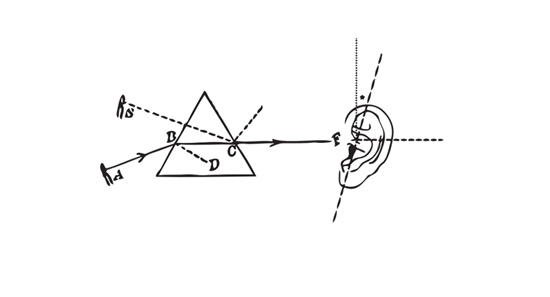
“Varying combination of sounds and “non-sounds” (silence) through time, sounding forms (Eduard Hanslick), time length pieces (John Cage). These definitions of music are referring to both a concrete and a non physical presence that are holding the vision of a special space-time constellation. The process of investigating the distribution of sounds is leading us to the magical state of the musical thought. Waiting, along the observation procedure are constructing an extension of the listeners traditional relationship with music.
What states might a musical thought have? How does interpretation is taking part in the process? How does representation affected? What are the bases of the musical experience? The exhibition is seeking to find these “in-between” states through the works of the New Music Studio , and students of Faculty of Music and Visual Arts University of Pécs and - of course - the presence of the visitors.” (from the exhibition catalogue)
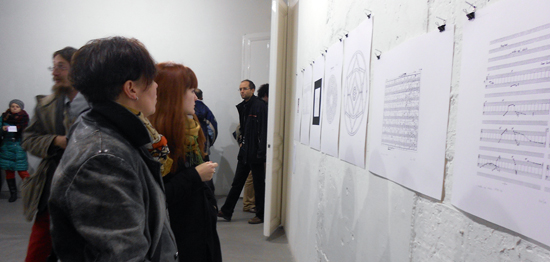
Exhibition Space (2B Gallery)
New Music Studio is a group of musicians formed in the seventies in Budapest. They were focusing on some kind of methodology and philosophy of the contemporary music scene that was different from the canonized mainstream. They brought “cageian” influences and the legacy of fluxus to the regions of eastern european society. The main founders of the group ( Laszlo Sary, Laszlo Vidovszky,Zoltan Jeney, Peter Eötvös, Zoltán Kocsis, András Wilheim et al) amongst other creative minds produced several interesting pieces that were questioning traditional musical interpretation methods, notation, performance and the articulation of musical expressions. Their legacy is hard to interpret hence the large amount of their pieces. These neither fit in the traditional performative space, also difficult to adjust to gallery spaces.
The exhibition is a truly great reflection to this situation: installations, homage works and cross references are introduced to the audience in order to shed light on most of these problematic aspects. The tribute works of the next generation are also deeply experimental and fresh pieces that are using post digital concepts the aesthetics of raw, ubiquitous, programmable electronics where people can focus on content and aural space instead of regular computers and the like. The presented spatial sound installations find their place perfectly in the gallery space. The collected documents and visual landmarks of the exhibition are giving hints on very interesting topics without the need for completeness which is a good starting point to dive into this world deeper. The exhibition is curated by Reka Majsai.
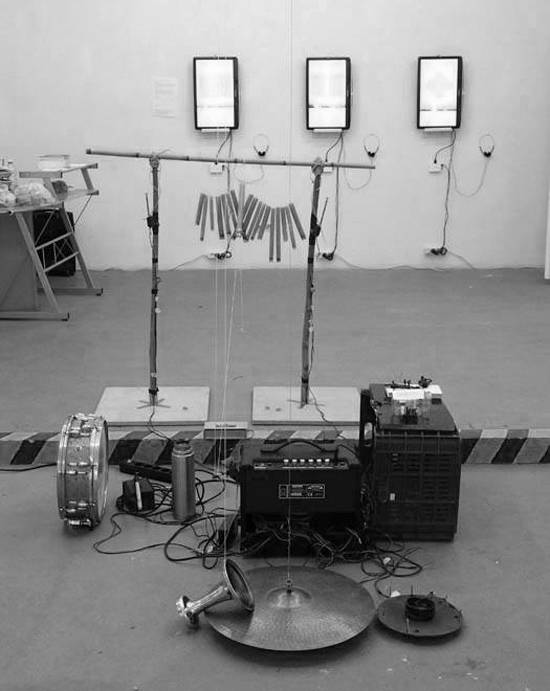
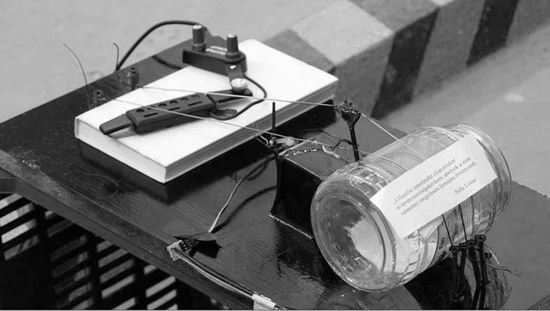
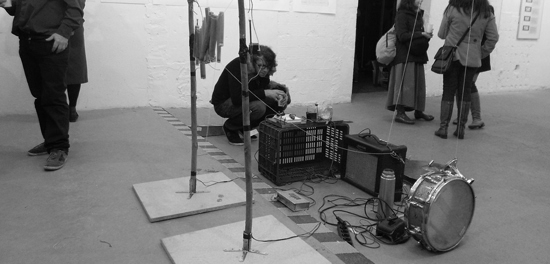
Hommage á Autoconcert (Balázs Kovács & students from University of Pécs)
“Hommage á Autoconcert” by Balazs Kovacs (xrc) [link] & students from the University of Pécs is a sound installation that is constructed of several found objects and instruments. It is a tribute to the so called “Autoconcert” (1972) by Laszlo Vidovszky. The original piece has a diverse set of found objects that are falling from above over different time intervals during the performance. The present installation is dealing with the sound events in a reproducible way: the objects are not falling, but get hit by small sticks from time to time. These events are constructing a balanced aural space where some tiny noise, amplified strings and colliding cymbals can be heard as some acoustic background layer. The sticks are moved by little servo motors, the logic is controlled by a few arduino boards .
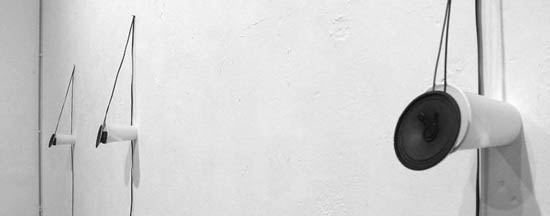
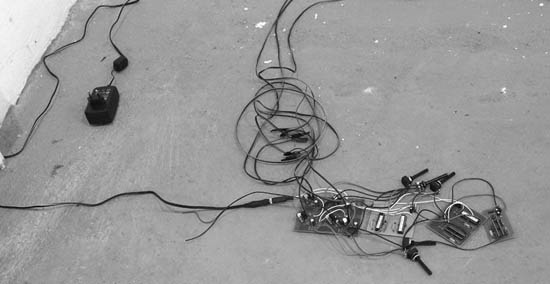
Repeating and overlapping of three musical processes (Gábor Lázár)
“Repeating and overlapping of three musical processes” by Gábor Lázár is also a sound installation made with custom micro controllers and three speakers set in plastic glasses as acoustic resonators. The processes are based on ever-changing time manipulations between musical trigger events. Dividing time within these in-between temporal events cause ever-increasing pitch shifting in the auditory field. The overall sound architecture forms a very saturated and diverse experience.
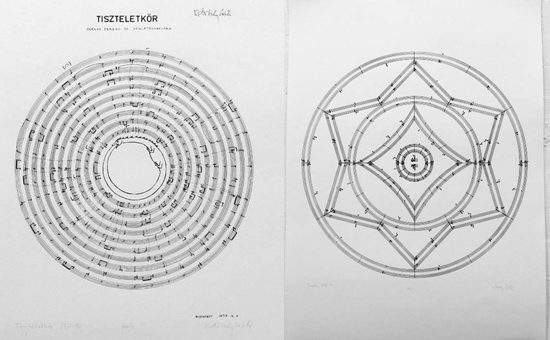
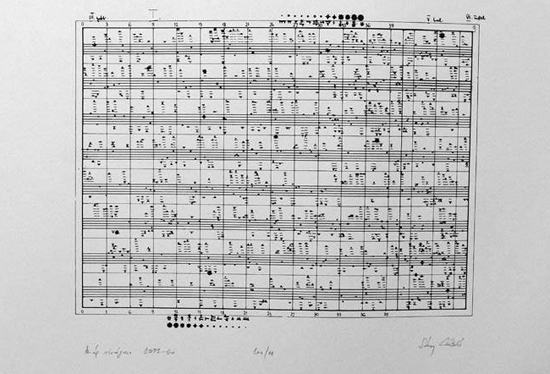
Visual Notations (New Music Studio)
“Visual Notations” by the New Music Studio members themselves are in fact several notation pieces crafted in a beautiful way. Varying nonstandard notation techniques are introduced here: using the graphical alignment of stellar constellations (Flowers of heaven, Sary), spiral like, self-eating dragon (Lap of honour, Vidovszky), ancient hindu symbols (Yantra, Jeney) are all taking part in the semantics and development in these sounding images.
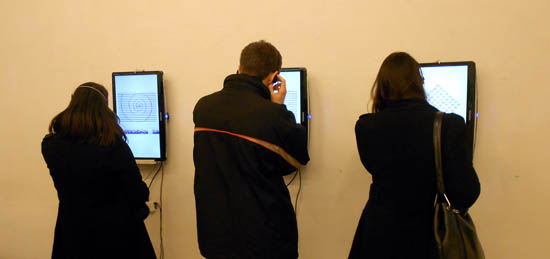
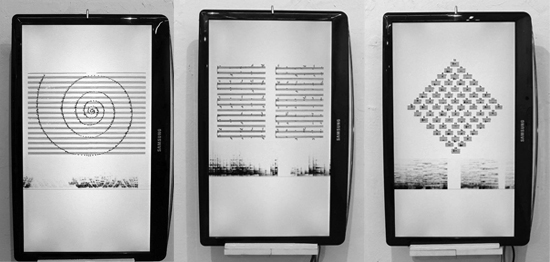
Three pieces by Sáry (reinterpretation & software by Agoston Nagy)
There is also an installation I’ve been involved with: interpreting three pieces by Laszlo Sary. The triptych is letting the observer see and hear the inner sound structures at the same time. The upper region of the screen is displaying the original notation, this can be referred to the piece as a spatial constellation of the sounds to be played. Each work has different notations and different instructions on how to play the notes. The bottom region is displaying a live spectrogram of the actual sound. This is showing a temporal distribution of the events which has different characteristics with each piece.

Musical Spectra of the three different pieces by Sáry
“Sunflower” (1989, based on Snail Play, 1975) has a spiral-like spatial distribution in the sheet, these patterns are clearly visible in the musical spectra: infinite ladders are running up and down as the musicians are playing on three percussive marimbas. “Sounds for” (1972) is based on some predefined notes that can be accessed by the performer in any order they prefer. Larger, distant, sudden triggers are defining a more strict, cityscape-like spectra. The final piece, “Full Moon” (1986) is based on a permutation procedure [link]: the individual notes are played back simultaneously by four (or more) musicians at the same time. Their individual routes are defining the final constellation of sounds. The visible spectra is like a continuous flow, where soft pitch intonations are in focus against the previous two, rhythm oriented works. The setup is made with free & open source tools, using OpenFrameworks on three raspberry pi boards.
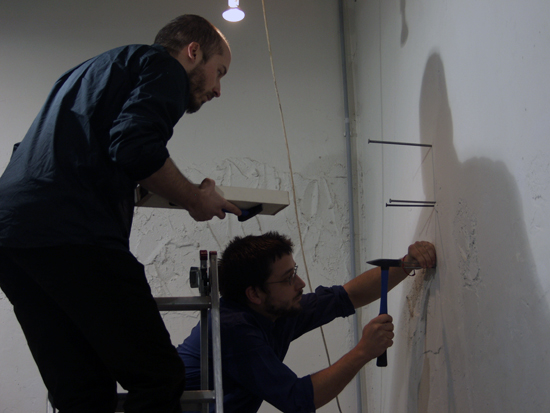
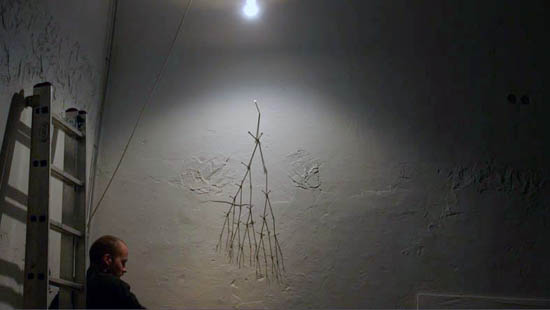
Images of the exhibition opening
It is hard to describe all the aspects of the exhibited works and the legacy of the New Music Studio, as their works had many local influences in the East European region at their time. The states of “in-between-ness” however are clearly recognizable on several layers of the whole event: the political and cultural influences of the original artists, the continuous phase shift between the musical and the visual domain, the tribute works where the creators are halfway in-between authors and interpreters. The exhibition is all together a really important summary of a niche cultural landmark in the Hungarian and international contemporary music scene.
Thanks for Gabor Toth for the photos.
Add comment
Fill out the form below to add your own comments